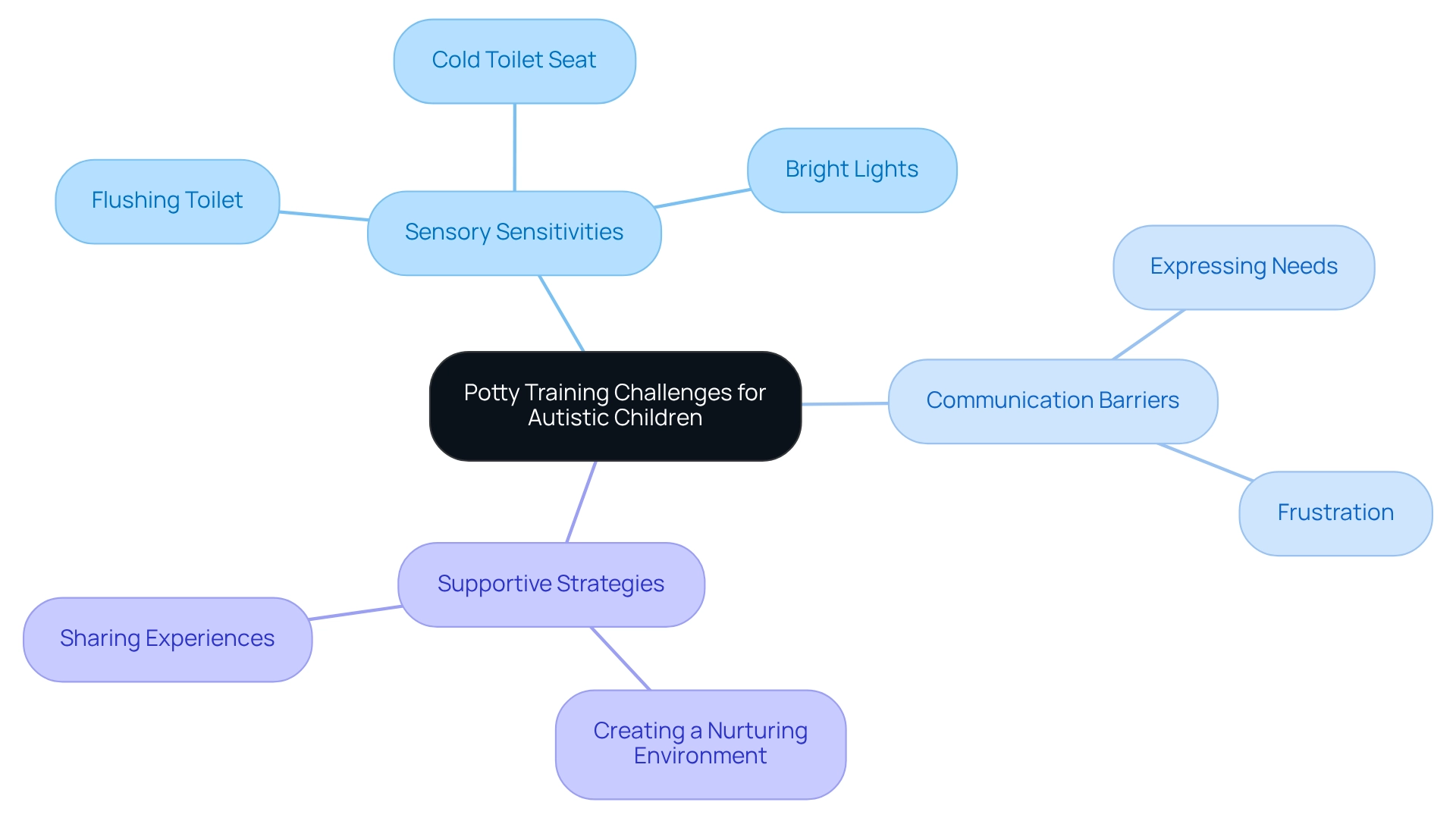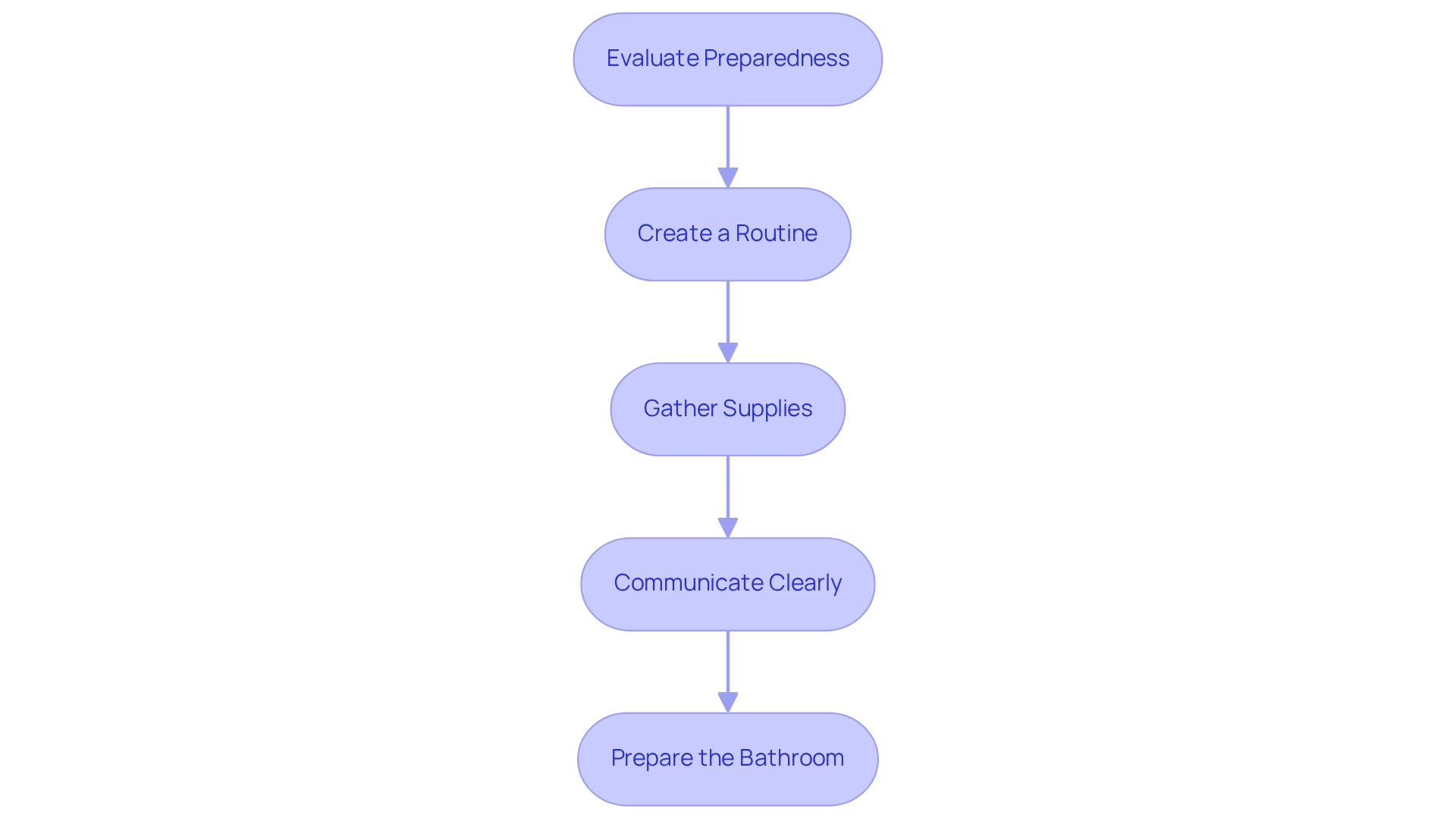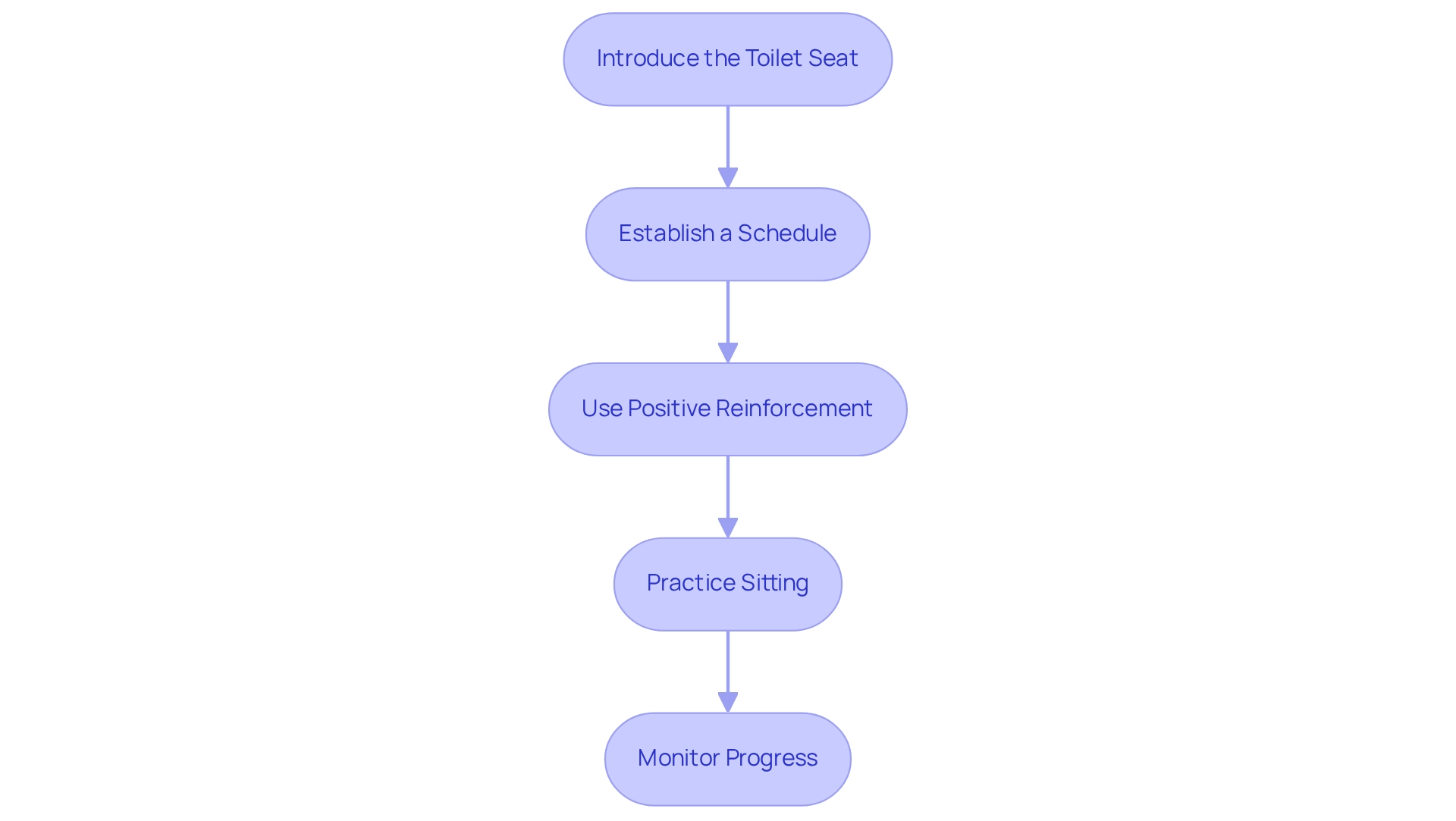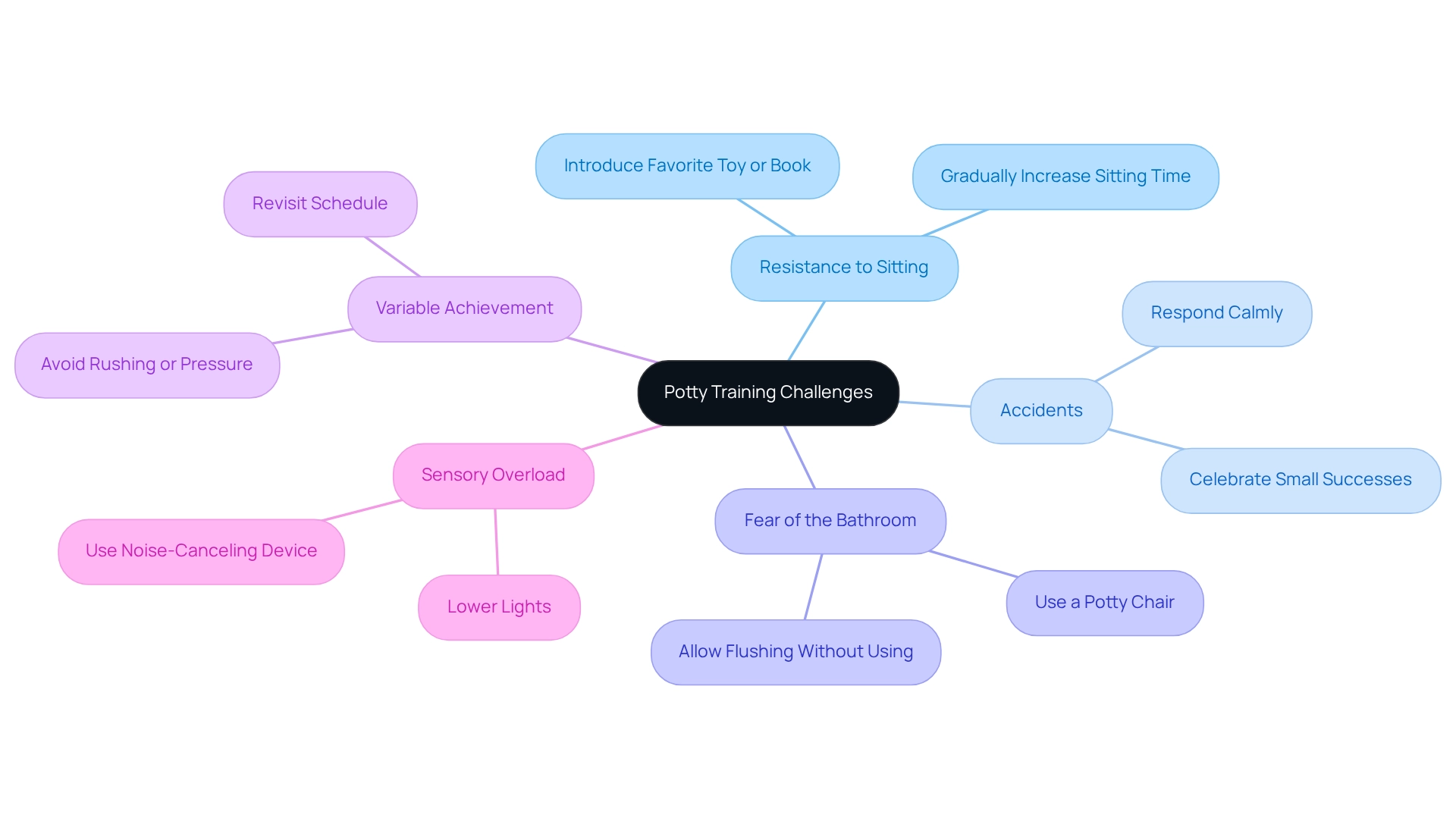Overview
Successfully potty training autistic children involves essential steps that recognize their unique sensory sensitivities and communication challenges. By preparing the environment and implementing a structured plan tailored to their needs, parents can make this journey smoother. Understanding these factors is crucial. By applying specific strategies—like establishing routines, using positive reinforcement, and creating a supportive atmosphere—parents can significantly enhance the potty training experience for their children.
Imagine the difference it can make when routines are in place, and encouragement is abundant. Parents often share how these small changes lead to big improvements. It’s about creating a nurturing space where children feel safe and understood. As you embark on this journey, remember that you are not alone. Many parents have walked this path and found success by embracing these strategies.
Consider joining a community where experiences can be shared, and support is readily available. By recognizing the unique needs of your child and adapting your approach, you can foster a positive environment that encourages growth and confidence. Together, let’s make potty training a positive milestone in your child’s development.
Introduction
Potty training can feel like a daunting journey for any parent, and for those with autistic children, the challenges can be particularly complex. Sensory sensitivities and communication barriers often turn the bathroom into a source of anxiety rather than a place of learning. Understanding these hurdles is crucial for developing effective strategies that cater to the unique needs of autistic children. This article explores the intricacies of potty training in this context, offering essential steps for preparation, a structured plan for implementation, and troubleshooting techniques for common challenges. By equipping parents with the right tools and insights, we aim to make the path to successful potty training a more manageable and positive experience for both the child and caregiver.
Understand the Unique Challenges of Potty Training for Autistic Children
Potty training autism can be particularly challenging for kids, often due to sensory sensitivities and communication barriers. Many autistic children are highly sensitive to sensory stimuli, which can make the bathroom environment feel overwhelming. For instance, the sound of a flushing toilet, the cold texture of a toilet seat, or the bright lights in a bathroom can trigger significant distress. Research shows that sensory processing issues are common among autistic youth, with tactile sensitivity scores indicating that those in the developmental disability (DD) group score 0.02 points lower than those with autism spectrum disorder (ASD). This underscores the importance of distinguishing between ASD and sensory modulation disorder (SMD), as recognizing these differences is vital for effective potty training autism strategies.
Additionally, communication delays can complicate the potty training autism process, as young children may find it difficult to express their needs or discomfort. This communication gap can lead to frustration for both the child and the caregiver, making it essential to develop strategies that cater to these unique challenges. As Lane observed, "Further examination of sensory subtypes and the role of taste/smell sensitivity are warranted based on the findings of the present study." Understanding these factors, including the significance of sensory symptoms as diagnostic criteria in the DSM-V, is crucial for creating a supportive toilet learning environment. This atmosphere can foster success while minimizing anxiety for the child.
As you navigate this journey, remember that you are not alone. Sharing experiences and strategies with other parents can be incredibly helpful. Let’s work together to create a nurturing space for our children, where they can thrive and feel comfortable during this important developmental milestone.

Prepare for Success: Essential Steps Before Starting Potty Training
Before embarking on the journey of toilet education, it's essential to prepare both your child and the environment. Here are some important steps to consider:
- Evaluate Preparedness: Look for signs that your child is ready for toilet learning, such as displaying interest in the bathroom or staying dry for longer periods. Research indicates that the duration of toilet training can vary, typically ranging from 2 to 7 days, which is crucial for fostering independence and confidence.
- Create a Routine: Establish a consistent schedule for bathroom visits. This helps your child understand when to expect restroom use, highlighting the importance of routine in the toilet training process.
- Gather Supplies: Make sure you have all the necessary items, including a comfortable potty chair, easy-to-remove clothing, and rewards for successful attempts. Positive reinforcement can greatly enhance motivation.
- Communicate Clearly: Use straightforward language and visual aids to explain the process. Social stories can be particularly beneficial in helping your child grasp what to expect. As Hope Gillette notes, 'Potty training autism doesn’t have to be stressful,' which can offer reassurance to parents during this time.
- Prepare the Bathroom: Transform the bathroom into a welcoming space. Consider using a footstool for stability and a soft seat cover to alleviate sensory discomfort. Addressing these environmental factors can significantly enhance your child's educational experience.
By focusing on these vital aspects, parents can create a nurturing environment that promotes potty training autism and effective toilet habits for their children. Additionally, understanding the unique challenges faced by individuals with autism, particularly in the context of potty training autism, as explored in the case study 'Understanding Autism's Impact on Potty Training,' can lead to meaningful improvements in their daily lives and overall well-being.

Implement a Structured Potty Training Plan: Step-by-Step Process
Implementing a structured potty training autism plan can be a rewarding journey for both you and your child. Here are several essential steps designed to support autistic children effectively:
- Introduce the toilet seat: Begin by allowing your little one to examine the chair. Encouraging them to sit on it fully clothed can help alleviate any anxiety associated with this new experience.
- Establish a schedule: Take your young one to the bathroom at regular intervals, such as every 30 minutes. As they grow more comfortable, gradually extend the time between visits to foster their independence.
- Use positive reinforcement: Celebrate each success with enthusiastic praise or small rewards. For instance, if your child uses the toilet, acknowledge their accomplishment with expressions like, 'Great job! You used the toilet!' Consider offering a sticker or a favorite snack as a reward. As Elizabeth Cross, Ph.D., a clinical psychologist at Kennedy Krieger Institute’s Center for Autism and Related Disorders, emphasizes, "Parents and caregivers need to be ready to dedicate the time to toilet training before they get started."
- Practice sitting: Encourage your little one to sit on the toilet for a few minutes, even if they don’t feel the urge to go. This practice helps them acclimate to the routine and reduces anxiety over time.
- Monitor progress: Keep a detailed record of successes and setbacks. Tracking this progress enables you to modify the schedule according to your child's comfort level and needs, ensuring a customized approach. At the end of the day, measuring and recording fluid intake can help monitor hydration levels.
Studies show that organized toilet instruction programs can lead to significant advancements in potty training autism and improve continence and self-initiation abilities among youngsters with autism. A study titled 'Long-Term Effects of Intensive Bathroom Instruction' concluded that intensive bathroom programs can result in sustained improvements in these areas, although further research is needed to evaluate long-term maintenance. By staying adaptable and attentive to your child's requirements, you can create a nurturing atmosphere that enhances their bathroom experience. Future research is suggested to assess the impacts of toilet education programs in domestic environments and to explore the importance of various elements of Intensive Toilet Education (ITE) packages.

Troubleshoot Common Potty Training Challenges and Adjust Strategies
Even with a structured plan, challenges may arise during toilet training. It’s important to remember that you’re not alone in this journey. Here are some common issues and compassionate ways to address them:
- Resistance to Sitting: If your little one resists sitting on the toilet, consider introducing a favorite toy or book to make the experience more enjoyable. Gradually increase the time they spend sitting, allowing them to feel comfortable.
- Accidents: Accidents are a normal part of the process. Respond calmly and avoid punishment. Instead, reinforce the idea that using the toilet is a positive behavior, celebrating small successes along the way.
- Fear of the Bathroom: If your little one is fearful of the bathroom, think about using a potty chair instead of a standard commode. Allow them to flush the toilet without using it to help them acclimate to the sound and environment.
- Variable Achievement: If your child demonstrates variable achievement, revisit the schedule and make adjustments. Ensure they are not feeling rushed or pressured, as this can hinder their progress.
- Sensory Overload: If the bathroom atmosphere feels excessive, consider lowering the lights or using a noise-canceling device to help your child feel more at ease.
Research indicates that 693 youngsters were identified as facing considerable toilet-related difficulties, highlighting the necessity for customized approaches. This statistic underscores the importance of addressing these challenges with effective interventions. A study on the long-term effects of intensive toilet preparation programs for children with autism found that participants maintained their skills over time, suggesting that consistent and supportive potty training autism interventions can yield lasting benefits. Pediatricians, as noted by Lisa D Wiggins, PhD at the CDC, are an important resource for families during the potty training journey, providing valuable guidance and support. Additionally, resources like 'The Potty Journey' guide by Judith A. Coucouvanis can offer further insights and strategies for parents navigating this process. Remember, every child is unique, and with patience and understanding, you can make this transition smoother.

Conclusion
Successfully navigating the potty training journey for autistic children requires a deep understanding of the unique challenges they face, including sensory sensitivities and communication barriers. Recognizing these factors is crucial for creating an effective training environment that reduces anxiety and fosters learning. By preparing adequately, establishing a structured potty training plan, and employing troubleshooting techniques, parents can significantly enhance their child's experience.
Preparation is key; assessing readiness, creating a routine, and ensuring a comfortable bathroom environment set the stage for success. Implementing a structured plan with clear steps helps children acclimate to the process and builds their confidence. Celebrating successes with positive reinforcement encourages motivation and reinforces desired behaviors.
Challenges are inevitable, but with the right strategies in place, they can be managed effectively. Addressing resistance, accidents, and sensory overload with patience and creativity will lead to a more positive experience. The journey may be complex, but with understanding and support, parents can help their children achieve successful potty training, ultimately contributing to their independence and overall well-being. Embracing this process with empathy and flexibility will pave the way for a brighter future in daily living skills.
Frequently Asked Questions
Why is potty training particularly challenging for autistic children?
Potty training can be challenging for autistic children due to sensory sensitivities and communication barriers. Sensory stimuli in the bathroom, such as the sound of a flushing toilet or the cold texture of a toilet seat, can be overwhelming for them.
What role do sensory sensitivities play in potty training for autistic children?
Many autistic children have heightened sensory sensitivities, making them more reactive to sensory stimuli in the bathroom environment. This can lead to distress and hinder the potty training process.
How do communication delays affect potty training in autistic children?
Communication delays can complicate potty training as children may struggle to express their needs or discomfort. This communication gap can lead to frustration for both the child and the caregiver.
What is the significance of understanding sensory processing issues in autistic children?
Understanding sensory processing issues is crucial for effective potty training strategies. It helps caregivers create a supportive environment that minimizes anxiety and fosters success during toilet learning.
What should caregivers consider when potty training an autistic child?
Caregivers should consider the child's sensory sensitivities and communication needs. Developing strategies that address these unique challenges is essential for creating a nurturing toilet learning environment.
How can parents support each other during the potty training process for autistic children?
Parents can support each other by sharing experiences and strategies. Collaborating with other parents can provide helpful insights and create a nurturing space for children during this developmental milestone.




